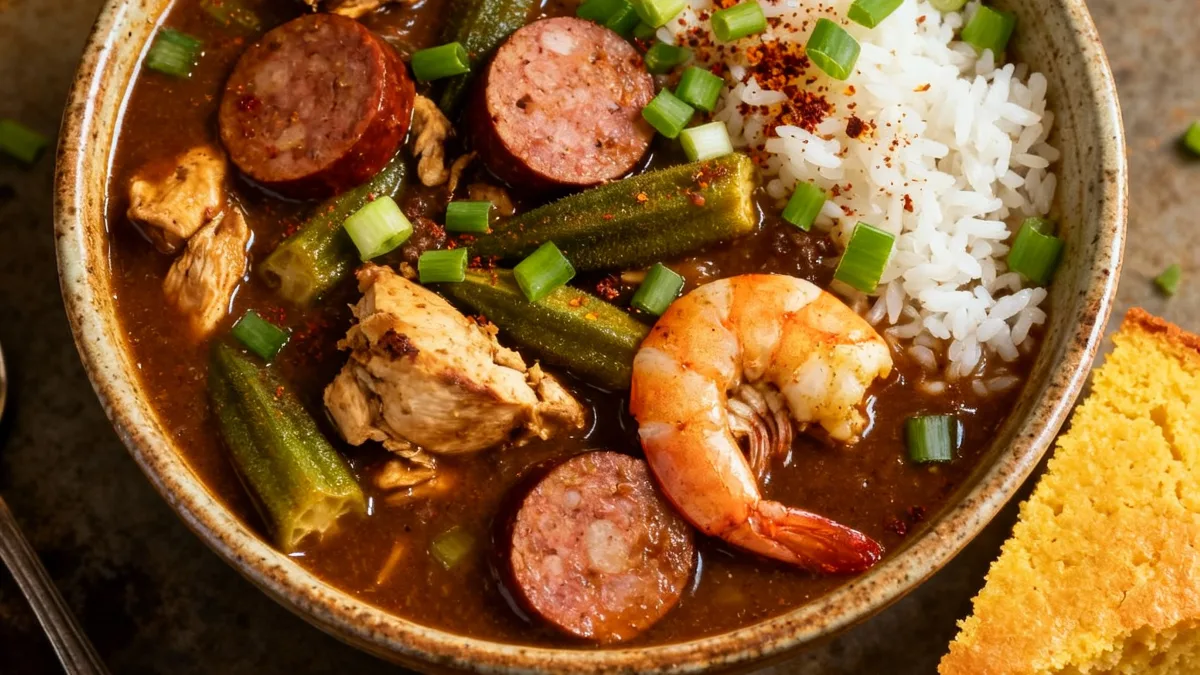The first time I tasted an authentic New Orleans gumbo, I was standing under the flickering lights of a French Quarter café, my spoon sinking into a bowl of deep, aromatic stew. The air smelled of smoked sausage, peppers, and that unmistakable dark roux that defines Creole cooking. One bite, and I understood why this dish isn’t just food it’s culture, history, and comfort all stirred together. My friend’s grandmother, a lifelong New Orleanian, leaned over and said, “Good gumbo takes patience, sugar. You don’t rush love or roux.” I never forgot that. Today, I bring that same love and soul to my kitchen whenever I make this New Orleans Gumbo Recipe a dish that celebrates both flavor and heritage.
Cultural & Historical Context
New Orleans gumbo is more than a recipe it’s a reflection of the city’s soul. The word “gumbo” is believed to come from the West African word ki ngombo, meaning okra. It evolved as French settlers, African slaves, and Native Americans shared techniques and ingredients. Each generation added its own touch African okra, French roux, Native American filé, and Spanish peppers. Gumbo became the symbol of Creole cuisine, representing unity through diversity. Today, it’s cooked in homes and restaurants across Louisiana, often served at family gatherings, Mardi Gras parties, and Sunday dinners.
Why This Gumbo Works
Authentic New Orleans gumbo isn’t just a stew; it’s a melting pot of cultures African, French, Spanish, and Native American influences blending beautifully. The flavor comes from layers: a deep, chocolate-brown roux made slowly, the “holy trinity” of onion, bell pepper, and celery sautéed to perfection, and rich stock simmering for hours. Whether you choose chicken and sausage or seafood, every spoonful bursts with smoky, spicy depth. The roux gives the gumbo its velvety texture, while okra and filé powder add body and traditional flair. Unlike quick stews, gumbo rewards patience the longer it cooks, the more soulful it becomes.
Ingredients & Substitutions
Below is a detailed look at the key ingredients that make this gumbo authentic and how you can customize it.
| Ingredient | Notes / Substitutions |
|---|---|
| Butter or Oil | Used to make the roux. Oil creates a deeper color; butter adds richness. |
| Flour | Essential for thickening and developing that deep roux flavor. |
| Andouille Sausage | Traditional smoked sausage adds heat and depth. Substitute kielbasa if unavailable. |
| Chicken Thighs | Juicy and tender, they absorb flavor beautifully. |
| Shrimp | Optional for a seafood variation; add at the end to prevent overcooking. |
| Okra | Classic Creole thickener. Can substitute with filé powder. |
| Bell Pepper, Onion, Celery | The Louisiana “Holy Trinity” the foundation of flavor. |
| Garlic | Enhances aroma and rounds out the base. |
| Cajun or Creole Seasoning | Adds spice; adjust heat level to your liking. |
| Chicken or Seafood Stock | Homemade or store-bought, it’s the heart of gumbo’s richness. |
| Filé Powder | Ground sassafras leaves, adds earthy depth and thickens the gumbo. |
| Rice | Traditionally served underneath the gumbo to soak up the broth. |
Variations
- Seafood Gumbo: Replace chicken with shrimp, crab, and oysters.
- Chicken and Sausage Gumbo: The most traditional New Orleans version.
- Vegetarian Gumbo: Use vegetable stock and mushrooms for umami flavor.
- Gumbo Z’herbes: A Lenten favorite packed with greens like collards, mustard, and kale.
Step-by-Step Instructions
Making a perfect gumbo takes time and care. Here’s how to build those signature layers of flavor.
Step 1: Make the Roux
In a large pot, combine equal parts flour and oil. Stir constantly over medium heat for 25–30 minutes until the roux turns a deep chocolate color. It’s a labor of love stop stirring for even a second, and you’ll burn it. The roux gives your New Orleans gumbo recipe that unmistakable rich flavor and color.
Step 2: Build the Base
Add chopped onions, bell peppers, and celery to the roux. Cook until softened and aromatic. Add garlic and cook one minute longer. This step lays the foundation of flavor.
Step 3: Add Proteins & Stock
Stir in sliced andouille sausage and chicken. Cook for a few minutes before slowly adding stock. Bring to a simmer, scraping the bottom to incorporate the roux fully. Add Cajun seasoning, bay leaves, and thyme. Let simmer uncovered for about an hour, stirring occasionally.
Step 4: Add Okra or Filé
Stir in okra during the last 30 minutes or sprinkle in filé powder off the heat before serving. These thickeners add that characteristic gumbo body.
Step 5: Finish with Seafood (Optional)
If using shrimp or crab, add them during the final 10 minutes. You want them tender, not rubbery.
Step 6: Serve Over Rice
Spoon steaming gumbo over fluffy white rice. Garnish with green onions, parsley, and a touch of hot sauce. The contrast between spicy stew and soft rice makes every bite sing.
Variations & Protein Options
New Orleans gumbo is endlessly adaptable. Here are a few popular spins:
- Creole Gumbo: Uses tomatoes and a slightly lighter roux, often includes shrimp or crab.
- Cajun Gumbo: Darker roux, bolder spices, and usually no tomatoes.
- Sausage and Chicken Gumbo: Rich, smoky, and hearty great for beginners.
- Seafood Gumbo: Lighter, briny, and packed with shrimp and crab.
- Vegetarian Gumbo: Swap meat for beans, mushrooms, and smoked paprika for that savory flavor.
Troubleshooting & Common Mistakes
Even seasoned cooks slip up when making gumbo. Here’s how to avoid common pitfalls:
- Roux Burned? Start over. Burned roux tastes bitter and ruins the dish.
- Too Thin? Simmer uncovered longer to reduce, or add a bit more filé.
- Too Thick? Add warm stock gradually until desired consistency.
- Over-salted? Drop in a peeled potato while simmering to absorb excess salt.
- No Andouille? Use smoked sausage or chorizo for a similar kick.
Serving, Pairing & Usage Ideas
Gumbo is best served hot over rice, but it’s just as good the next day. Pair it with cornbread, potato salad, or a crusty baguette to soak up the sauce. For drinks, a cold Abita beer or a glass of chilled Riesling complements the spice beautifully. Leftovers can be turned into gumbo pie or gumbo-stuffed bell peppers perfect for reimagining your meal.
Make-Ahead, Storage & Reheating
Gumbo tastes even better the next day as flavors meld together. Store in an airtight container in the fridge for up to 5 days or freeze for 3 months. Reheat slowly on the stove, adding a splash of stock to loosen it up. Avoid microwaving it can make proteins rubbery and separate the roux.
Nutrition & Macros
Here’s the approximate nutrition per serving (1 ½ cups gumbo + ½ cup rice):
| Nutrient | Amount |
| Calories | 420 |
| Protein | 28g |
| Fat | 20g |
| Saturated Fat | 6g |
| Carbohydrates | 30g |
| Fiber | 3g |
| Sugar | 5g |
| Sodium | 890mg |
Gumbo isn’t light fare, but it’s wholesome and satisfying. For a lighter version, reduce sausage and use brown rice instead of white.
FAQs
Can I make gumbo ahead of time?
Yes, gumbo develops richer flavor overnight. It’s a great make-ahead dish for gatherings.
Do I have to use okra?
No, you can substitute filé powder or simply cook longer for a thicker texture.
What’s the difference between Cajun and Creole gumbo?
Cajun versions skip tomatoes and have darker roux; Creole gumbo includes tomatoes and is slightly milder.
How do I make gluten-free gumbo?
Use rice flour or gluten-free all-purpose flour for the roux.
Conclusion
This New Orleans Gumbo Recipe captures everything that makes Southern cooking special heart, flavor, and heritage. Whether you’re stirring a roux for the first time or carrying on a family tradition, gumbo connects us to something deeper. Take your time, taste as you go, and savor the moment. Once you master it, you’ll never look at stew the same way again. So grab your spoon, turn up some jazz, and make a pot of gumbo that tells your own story.

New Orleans Gumbo
Ingredients
Method
- Make the roux: In a large pot, combine flour and oil over medium heat. Stir constantly for 25–30 minutes until dark chocolate brown. Do not burn.
- Add onion, bell pepper, and celery to the roux. Cook until softened, about 5 minutes. Add garlic and cook 1 minute more.
- Stir in sausage and chicken. Cook for 3–5 minutes, allowing the meat to absorb flavors.
- Slowly add stock while stirring to combine with the roux. Add Cajun seasoning, bay leaves, and bring to a simmer.
- Simmer uncovered for about 1 hour, stirring occasionally. Add okra during the last 30 minutes.
- If using shrimp, add them during the final 10 minutes and cook just until pink and tender.
- Remove from heat and stir in filé powder if desired for extra thickness and flavor.
- Serve gumbo hot over white rice, garnished with green onions, parsley, and a dash of hot sauce.

